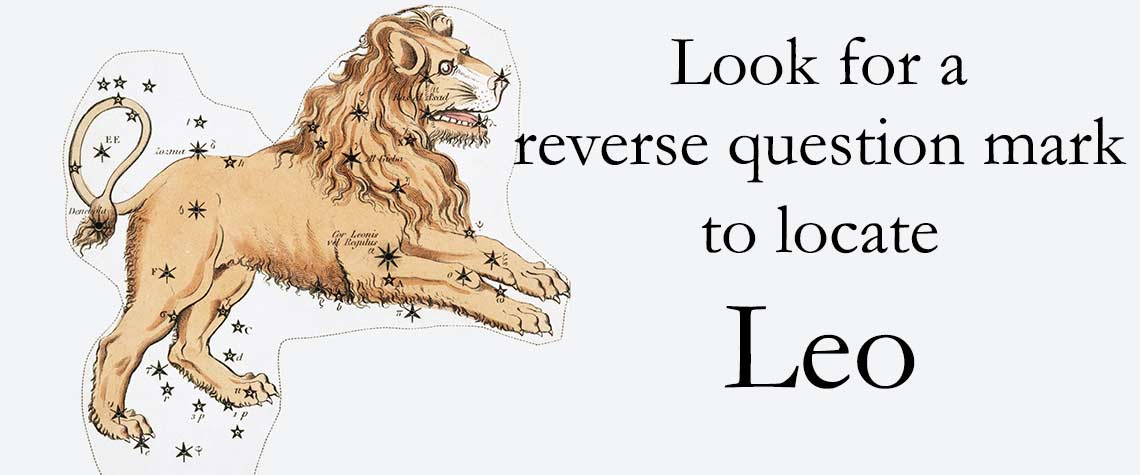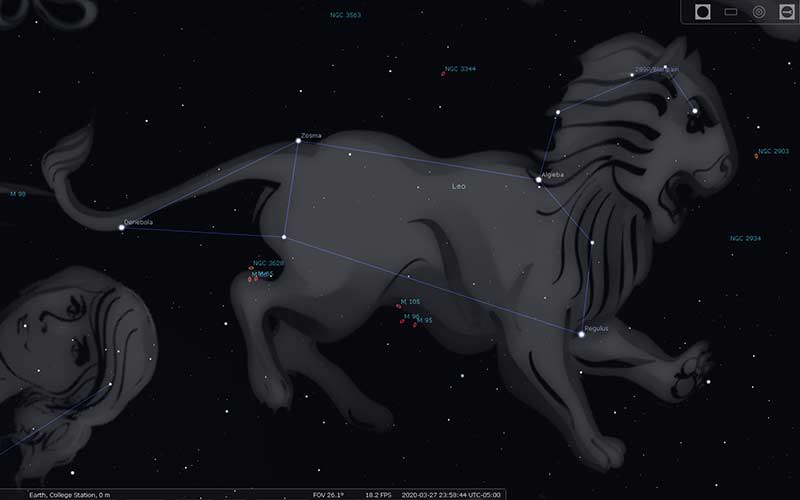Page 6


EYE ON THE SKY - LEO
By Tom Campbell
Leo is one of the 13 constellations of the Zodiac, meaning that the Sun passes through it at some point in our yearly orbit. The reverse question mark shape of his mane is easily recognizable in the spring sky.
Probably the most famous legend involving Leo is the Greek myth about the Nemean Lion, who lived on the Moon and one day it leaped to Earth, appearing as a shooting star. It landed in Corinth and started wreaking havoc on the countryside. Hercules wrestled it with his bare hands and eventually was able to strangle it. After the battle, Zeus put the lion back in the sky where he belonged.
The Babylonians had an ancient version of Romeo and Juliet, a story of two lovers, Pyramus and Thisbe. They were deeply in love, but their parents were against the match. They communicated through cracks in the wall that connected their homes and arranged for a secret meeting in the forest.
Thisbe arrived first and noticed a large lion nearby, feeding on an animal. Scared and wanting to warn her boyfriend, she hurried off back towards town, dropping her veil in the process. The veil blew in the wind and landed near the lion, where blood from his fresh kill soaked into it.
After his meal, the lion left the area. Shortly thereafter, Pyramus arrived on the scene. Seeing no sign of his lover but spotting her blood-soaked veil in the grass nearby, he concluded a lion must have eaten her. Overcome with grief, he drew his sword and killed himself.
Not finding Pyramus at home, Thisbe returned to their secret meeting place. Seeing what happened, she broke down in tears, pulled the sword from Pyramus' body and thrust it into herself, joining him in death.
Jupiter had pity on the couple and placed Thisbe's veil in the sky, where we can still see it laying beside the lion as Coma Berenices.
Spring is a time when the evening sky is pointed away from the galactic plane. Because of this, we see fewer star clusters and nebulae (most of which are located within our own galaxy), and a lot more distant galaxies. Although nearby Virgo is probably the most famous constellation for finding galaxies, Leo has its fair share. (A lion's share, perhaps?) I've included some of the best ones here. Can you find them all?
Regulus (α Leonis) is the brightest star in the constellation of Leo and is sometimes referred to as the "heart" of the Lion. The name Regulus is Latin for "prince" or "little king."
The Regulus system consists of 4 or more stars. A white dwarf companion is close enough to Regulus A that they orbit their center of mass once every 40 days.
Regulus A itself is about 3.5 times the mass of our Sun and is spinning very rapidly, completing a rotation every 16 hours. By contrast, the Sun rotates once every 24 days at the equator. This equates to a rotational speed of 200 miles per second. If the star were spinning just 5% faster, its gravity would no longer be able to hold it together.
At low magnifications, Regulus B and Regulus C visually appear as a single star, separated from the primary by a wide 177 arc-seconds. At higher power, however, B and C can be split into two distinct stars.
Algieba (γ Leonis) is a red giant with a yellow giant companion. The pair can easily be separated in modest telescopes and make a beautiful sight. In 2009, an exoplanet was discovered to be orbiting the primary star.
Messier 65 is part of the Leo Triplet of galaxies, along with Messier 66 and NGC 3628. These three galaxies are close to each other both physically and visually, with all of them appearing in the same field of view at low magnifications.
M65 is low in dust and the ratio of old stars to new stars is quite high. However, the disk is slightly warped due to a burst of relatively recent star formation in the arms, believed to have been caused by the interaction of the other two galaxies 800 million years ago.
Messier 66 is perhaps a bit more interesting to look at than M65 because it is tilted towards us somewhat, revealing some of its spiral structure in dark skies. An interesting side-note is that this galaxy was the home to 5 supernovae since 1973.
NGC 3628 has been nicknamed the Hambuger Galaxy due to the shape of its 300,000 light-year tidal tail. It is the third member of the Leo Triplet. A large, dark dust band intersects the galaxy, creating the "hamburger" between two starry buns.
Messier 95 is a barred spiral galaxy, with an inner ring of stars surrounding the bar structure.
Messier 96 is a spiral galaxy, but is very asymmetric. The dust lanes are unevenly placed and the core is not at the exact center of the structure. It is believed that the odd shape is due to gravitational interactions with other nearby galaxies.
Messier 105 is an elliptical galaxy that is nearly circular. The center of the galaxy contains a supermassive black hole, about 140 million times more massive than our Sun.
NGC 3384 is an elliptical galaxy in the same field of view as M105, although it is highly flattened. Eighty percent of the stars in the core of this galaxy are estimated to be over a billion years old.
| Object | Type | Mag(s) | Dist. (ly) | R. A. | Dec. |
|---|---|---|---|---|---|
| α Leo (Regulus) | Multiple Star | 1.4, 8.1 | 79 | 10h 08.4m | +11° 58' |
| γ Leo (Algieba) | Double Star | 2.3, 3.5 | 130 | 10h 20.0m | +19° 50' |
| Messier 65 | Spiral Galaxy | 10.2 | 35,000,000 | 11h 18.9m | +13° 06' |
| Messier 66 | Spiral Galaxy | 8.9 | 31,000,000 | 11h 20.3m | +12° 59' |
| NGC 3628 | Spiral Galaxy | 10.2 | 35,000,000 | 11h 20.3m | +13° 35' |
| Messier 95 | Spiral Galaxy | 11.4 | 32,600,000 | 10h 44.0m | +11° 42' |
| Messier 96 | Spiral Galaxy | 10.1 | 31,000,000 | 10h 46.8m | +11° 49' |
| Messier 105 | Elliptical Galaxy | 10.2 | 36,600,000 | 10h 47.8m | +12° 35' |
| NGC 3384 | Elliptical Galaxy | 10.9 | 35,100,000 | 10h 48.3m | +12° 38' |

Tom Campbell
Website: http://astro.tomandjul.com/
